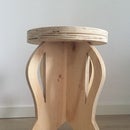Introduction: Metal Casting Sand
What do you need:
- Sand for casting
- 3D printed design model
- Mold box
- Pure aluminium scraps
- Oven (up to 990 degree)
Step 1: Prepare the Model
In my case the model was a hold candle a bit curved, so you can touch the curved surface and play with the wax while is falling down.
Step 2: Mold Boxes With Casting Sand
Filling your mold boxes with Sand:
When you fill your box with sand, use a hammer or other tool which you can hit harder on the sand. Don't leave space in the sand.
In my case I put my 3D model together with other models.
Removing the 3D printed wasn't easy then we thought because of the very high pressure of the sand. We used a 3D pen to add little tips from which to pull up the models.
Like this, we were able to take the models off obtaining a good negative.
Step 3: Melting the Aluminium
For the casting, we decided to use aluminum scraps that we found in the metal workshop.
We placed inside an iron container (which has a higher melting temperature of aluminum).
To melt the pieces we used an oven who reaches very high temperature but to make the process a little bit faster we used a blow torch, placing the container on top of a heat resistant brick in the workshop.
Step 4: Casting
After that, we poured the melted aluminum inside the mold.
This was the best part ever! We gently poured the liquid metal in and then waited for it to cool down. To make it faster I removed my when it was still a bit hot and placed it under cold water. The sand burned a little giving a black mark to the top cone, but it came out pretty easily by rubbing the model under cold water.
Unfortunately, the metal was not liquid enough so it formed an extra piece at the bottom, which is impossible to remove without ruining my candle holder.
What is really nice is that you can notice the lines that the 3D model had on the top are visible also in the metal piece. It looks almost like a fossil.












